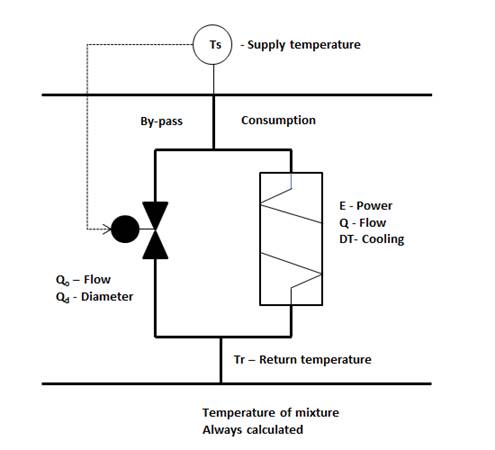Nodes
The following can be simulated in nodes:
· Loads produced from nominal or measured values at consumer level. Alternatively, consumption can be given as zero.
· Thermostatic bypass
· Bypass with fixed diameter or Kv value
· Production plants
· Shunt valves
· Accumulators
In addition, the node is a coupling between one or more pipes (max. 8). The model describes the nodes by providing names, coordinates, an elevation, a cooling or return temperature and information on bypasses.

Model of a node and its potential controls.
Consumers can be divided into categories. This makes it possible to execute a simulation with varying load factors depending on consumer category. The consumer categories are defined by the user. Up to 99 different categories can be defined. Categories are characterised by category type numbers (1 – 99) and corresponding names. A factor by which the customer's recorded power requirements is to be multiplied is indicated for every category as a function of the outdoor temperature. In a similar way, type curves are defined for the customer's cooling as a function of the outdoor temperature and the return temperature as a function of the outdoor temperature.
· Every consumer can belong to only one category, but a node can stand in relation to many consumers with different categories.
· A single node, such as a branch, is the same thing as a node without a load.
· A production plant is a node where supplements have been made to the node information for supply temperature, possible production quantity and absolute pressure.
The accumulators work in two ways:
· The accumulator can be given an unknown power consumption. This may be useful when the calculations are to be used as dimensioning tools for accumulators.
· The accumulator can be given a given power consumption with a set of power factors. This allows the behaviour of an accumulator to be checked.
The accumulators in question are expected to behave as follows:
· Power is stored at a constant return temperature which is the same as the accumulator's minimum temperature, Tmin, depending on the stratification of the liquid in the accumulator.
· When power is extracted, this takes place at a constant temperature which is the same as the accumulator's maximum temperature, Tmax, depending on the stratification of the liquid in the accumulator.